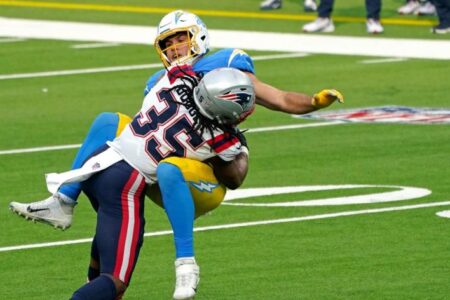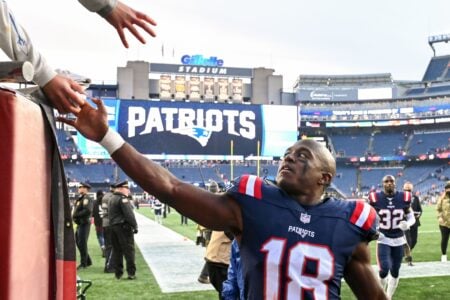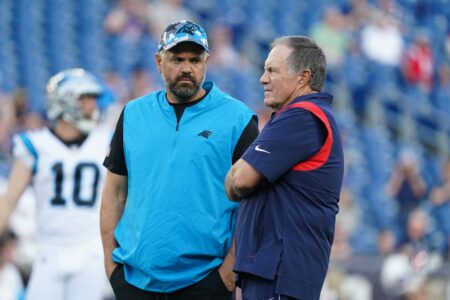There are many layers to the affect the Giants defensive line had on Sunday's game. But start with perhaps the most impactful component - The ability to handle Kevin Faulk. All year, and really in the past, Faulk has been invaluable as a checkdown option, and a way to deal with a strong pass-rush or press coverage on the perimeter. The Giants' pass rush, first and foremost, forced the Patriots to keep Faulk into block quite a bit. And from there, they covered him well (even if he had seven catches). One way of doing it was sending a linebacker up the middle. Faulk would pick the blitz, and then the 'backer (often Antonio Pierce) wouldn't let him peel off to where Tom Brady could get him the ball. When the Giants did let Faulk release, there was often a defensive back, and not a linebacker, waiting for him. The result? By taking away an option underneath through coverage, the rush got an extra split-second to get there. The bottom line is that the Giants wouldn't let Faulk kill them, the way he did the Jaguars and Chargers, and that was debilitating for the struggling pass protection.
One more thing on Faulk, and Wes Welker, that needs to be pointed out was how well the Giants handled the Patriots screen game, usually their antidote for a strong pass rush. The credit here has to go to the defensive backs. Late in the first half, the Patriots started running jailbreak screens - where a receiver drops behind the line and slips underneath blocking wideouts and linemen releasing to the flat - to slow the Giants pressure. On the first one, the Patriots converted a third-and-13 with Donte' Stallworth navigating through blocking for 18 yards. Later in the drive, Welker picked up 9 yards on another one. And that was that. On the Patriots' first drive of the third quarter, Corey Webster and Aaron Ross aggressively shed blocks from Randy Moss and Jabar Gaffney to drop Welker for a 2-yard loss. Then, on the final play of the third quarter, defensive linemen quickly recognized another one coming, and hustled to the flat in pursuit. That cut off angles for Stallworth, who was held to 9 yards on a third-and-15. To me, that's a sign of good coaching. Scheme-wise, not much had changed. But the message had been hammered home on how to approach these plays (corners taking blocks head on and linemen pursuing), and clearly got through. In turn, a major vehicle for slowing the pass rush, the screen game in general, was rendered a non-factor.
Another key - and Steve Spagnuolo said this to me by the team bus - was the defense's ability to disguise its rush. It's easy to see what a good job they did. The team's first sack of the game is a good example. On the play, a second-and-10 from the Patriot 30, Kawika Mitchell cheated up to the line. At the snap, he turned his hips, as if to drop into coverage. The protection adjusted, with Faulk going to pick up blitzing corner Aaron Ross, coming hard off the edge. And the second Faulk went, Mitchell sprinted at Brady on a free rush, blasting the quarterback and setting up another sack on third-and-17. And it wasn't just disguising the rush, but also the coverage that created sacks. Go to the second-and-10 on the Patriots' last gasp series with seconds left. There, safety Gibril Wilson starts out in the box, as if he's going to cover underneath, with Randy Moss and Corey Webster alone to the offensive left. But just before the snap, Wilson bailed into deep half coverage, giving Webster over-the-top help. So what Brady saw at the line changed at the snap and it looked like that by the time he adjusted his pre-snap read, Jay Alford was there to usher him to the turf.
Seems to me like the Tech alum Welker would've been MVP if the Patriots had won the Super Bowl. But I'll say this: The Giants did not do a bad job on him. With the exception of a couple of third-quarter plays (15- and 19-yarders), New York was able to get him to the turf quickly after the catch, and hit him constantly. That's the key with Welker, as good as he is after the catch and in the open field in general. The Patriots did things to free him, motioning him to stack-release (underneath another receiver), calling route combinations that made it tough to track him off the line, and motioning him away from slot corner Aaron Ross. But the truth is, he could've done more damage, had the Giants not played good, disciplined ball against him. And of course, you have to credit Webster, who I honestly felt was right up there with Justin Tuck and Eli Manning for MVP, for the job he did on Randy Moss.
Another unsung hero on defense for the Giants had to be defensive tackle Barry Cofield. His ability to occupy blockers helped free Tuck for one-on-ones on Logan Mankins, the Patriots' steady All-Pro guard who's one of the best in the game, but was absolutely undressed by Tuck's athleticism. On both the sacks, Cofield lined up shading center Dan Koppen and quickly engaged him, then used an outside move to get to guard Stephen Neal. So out there on the left edge, you had Osi Umenyiora on Matt Light (a relative wash of a matchup), and Tuck on Mankins. Obviously, the Giants knew that the Patriots hadn't seen many inside rushers - Tuck lined up as a 3-technique - with this guy's speed. And it was smart to put him on the weak-side, and work to create these one-on-ones.
 .
.

















